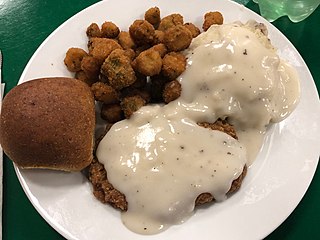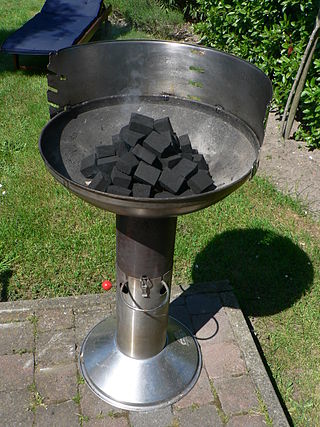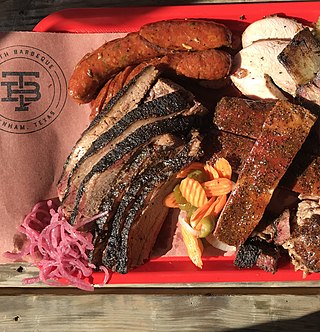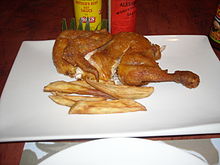
Midwestern cuisine is a regional cuisine of the American Midwest. It draws its culinary roots most significantly from the cuisines of Central, Northern and Eastern Europe, and Indigenous cuisine of the Americas, and is influenced by regionally and locally grown foodstuffs and cultural diversity.

A hamburger, or simply burger, is a sandwich consisting of fillings—usually a patty of ground meat, typically beef—placed inside a sliced bun or bread roll. Hamburgers are often served with cheese, lettuce, tomato, onion, pickles, bacon, or chilis; condiments such as ketchup, mustard, mayonnaise, relish, or a "special sauce", often a variation of Thousand Island dressing; and are frequently placed on sesame seed buns. A hamburger patty topped with cheese is called a cheeseburger.

Teppanyaki, often confused with hibachi, is a post-World War II style of Japanese cuisine that uses an iron griddle to cook food. The word teppanyaki is derived from teppan, the metal plate on which it is cooked, and yaki, which means grilled, broiled, or pan-fried. In Japan, teppanyaki refers to dishes cooked using a teppan, including steak, shrimp, okonomiyaki, yakisoba and monjayaki.

Jollibee is a Filipino chain of fast food restaurants owned by Jollibee Foods Corporation (JFC). As of September 2023, there were over 1,500 Jollibee outlets worldwide, with restaurants in Southeast Asia, the Middle East, East Asia, North America, and Europe.

Chicken-fried steak, also known as country-fried steak, (CFS) is an American breaded cutlet dish consisting of a piece of beefsteak coated with seasoned flour and either deep-fried or pan-fried. It is sometimes associated with the Southern cuisine of the United States. It is breaded and fried with a technique similar to the more common fried chicken, hence "chicken-fried". When deep-fried, it is usually referred to as "chicken-fried steak". Pan-fried versions are typically referred to as "country-fried steak".

Panda Express is an American fast food restaurant chain that specializes in American Chinese cuisine. With over 2,200 locations, it is the largest Asian-segment restaurant chain in the United States, where it was founded, and is mainly located in North America and Asia. Panda Express restaurants were traditionally located in shopping mall food courts, but the chain now operates units in many other environments and formats, including stand-alone restaurants, as well as universities, casinos, airports, military bases, amusement parks and other venues.

Filipino cuisine is composed of the cuisines of more than a hundred distinct ethnolinguistic groups found throughout the Philippine archipelago. A majority of mainstream Filipino dishes that compose Filipino cuisine are from the food traditions of various ethnolinguistic groups and tribes of the archipelago, including the Ilocano, Pangasinan, Kapampangan, Tagalog, Bicolano, Visayan, Chavacano and Maranao ethnolinguistic groups. The dishes associated with these groups evolved over the centuries from a largely indigenous base shared with maritime Southeast Asia with varied influences from Chinese, Spanish and American cuisines, in line with the major waves of influence that had enriched the cultures of the archipelago and adapted using indigenous ingredients to meet local preferences.

Kare-kare is a Philippine stew that features a thick savory peanut sauce. It is generally made from a base of stewed oxtail, beef tripe, pork hocks, calves' feet, pig's feet or trotters, various cuts of pork, beef stew meat, and occasionally offal. Vegetables, such as eggplant, Chinese cabbage, or other greens, daikon, green beans, okra, and asparagus beans, are added. The stew is flavored with ground roasted peanuts or peanut butter, onions, and garlic. It is colored with annatto and can be thickened with toasted or plain ground rice. Variations of kare-kare can be made with seafood, such as prawns, squid, and mussels, or exclusively from vegetables.

Pancit, also spelled pansít, is a general term referring to various traditional noodle dishes in Filipino cuisine. There are numerous types of pancit, often named based on the noodles used, method of cooking, place of origin, equal and constant diameter or the ingredients. Most pancit dishes are characteristically served with calamansi, as its freshly-squeezed juice may be used for additional seasoning.

Romacorp Inc., which does business as Tony Roma's, is an American casual dining chain restaurant specializing in baby back ribs. The first location was established by the founder, Tony Roma, in 1972 in North Miami, Florida. Clint Murchison Jr. purchased a majority stake in the restaurant in 1976, and he and Roma established the jointly owned Roma Corporation. The first international location opened in 1979 in Tokyo, followed by an international expansion with both company-owned stores and franchises. As of 2020, there are over 115 locations on six continents.

Barbecue varies by the type of meat, sauce, rub, or other flavorings used, the point in barbecuing at which they are added, the role smoke plays, the equipment and fuel used, cooking temperature, and cooking time.
Engracia Cruz-Reyes was a Filipino chef and entrepreneur. She was an active promoter of Filipino cuisine, especially through the restaurant chain she founded, The Aristocrat.

Mami is a popular Filipino noodle soup made with wheat flour noodles, broth and the addition of meat or wonton dumplings. It is related to the pancit class of noodle dishes, and the noodles themselves are sometimes called pancit mami.

Texan cuisine is the food associated with the Southern U.S. state of Texas, including its native Southwestern cuisine influenced Tex-Mex foods. Texas is a large state, and its cuisine has been influenced by a wide range of cultures, including Tejano/Mexican, Native American, Creole/Cajun, African-American, German, Czech, Southern and other European American groups.
TasteAtlas is an experiential travel online guide for traditional food that collates authentic recipes, food critic reviews, and research articles about popular ingredients and dishes. Describing itself as "a world atlas of traditional dishes, local ingredients, and authentic restaurants", it features an interactive global food map with dish icons shown in their respective regions and purportedly contains nearly 10,000 dishes, drinks, and ingredients, as well as 9,000 restaurants.
Max's Group, Inc., formerly the Max's Group of Companies, is a restaurant company in the Philippines.

Silog is a class of Filipino breakfast dishes containing sinangag and itlog. They are served with various viands or ulam, usually meat dishes such as tapa, longganisa or ham. The name of the accompanying meat dish determines the portmanteau name of the silog; for example, the former three would be known as tapsilog, longsilog, and hamsilog.

















